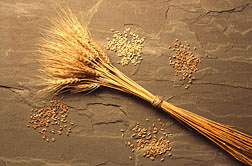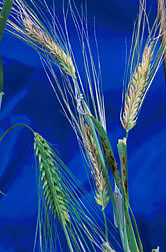GrainGenes Website Speeds
Discovery of Familiar Grains’ Unfamiliar Genes
|
|
Hearty grains—the oats in your breakfast cereal, the wheat in oven-fresh dinner rolls—are a mainstay of everyday meals. Given their importance, it’s no wonder that discoveries about the genetic makeup of oats, wheat, barley, and other so-called small grains have their very own home on the Web, a site aptly named “GrainGenes.”
This specialized Web venue is a magnet for savvy scientists who are hot on the trail of genes of about a half-dozen different grain-bearing plants. The site garners enthusiastic repeat visits from researchers worldwide because it is comprehensive, user friendly, and chock-full of interesting information.
By going to http://wheat.pw.usda.gov, visitors can search, browse, and download what they need for their grain-gene investigations. That’s according to geneticist Olin D. Anderson, who heads the ARS Genomics and Gene Discovery Research Unit. The unit is part of the agency’s Western Regional Research Center at Albany, California, near Berkeley.
|
|
Anderson’s Albany colleagues, plant geneticist Gerard R. Lazo and team member David E. Matthews, an ARS bioinformaticist based in Ithaca, New York, manage GrainGenes. This ongoing assignment includes collating, cross-indexing, and curating the more than 2.1 million pages that make up the site. Need-to-know text and graphics are added every business day. That includes, of course, findings from the Genomics and Gene Discovery team’s own research laboratories (see “Wresting Wheat’s Genetic Secrets,” Agricultural Research, September 2007).
Something for Everyone
GrainGenes is intended to quicken discoveries by a range of scientists, not only those who are sleuthing the structure and function of cereal-crop genes, but also those who carry out traditional crop breeding. Both areas of endeavor can lead to superior new plants for tomorrow that can, for example, shrug off attack by insect and disease enemies or thrive on salty soils—while at the same time producing impressive yields of plump kernels for making excellent flour.
|
|
Besides visiting GrainGenes to stay up to speed, users also contribute data of their own for the Albany team to post and share at the site. The website hastens the free exchange of such information, enabling researchers to more easily stay abreast of new findings in their own field of expertise—and discoveries in closely related fields, as well. “With GrainGenes,” says Anderson, “researchers can avoid accidentally repeating experiments that others in the United States or abroad have already conducted.”
In addition to helping well-established researchers, GrainGenes is also a great place for newcomers. “This site is geared for fast and easy use and for one-stop shopping,” notes Anderson. “It’s ideal as a primary or initial site for researchers to visit, to begin inquiries.”
A visitor who wants to know the state of knowledge about wheat genes that may confer resistance to a major wheat disease known as “Fusarium head blight,” for instance, can quickly delve into multiple layers of in-depth information in a variety of formats. Those include references to must-read literature; genetic and physical maps of chromosomes, indicating the approximate location of disease-resistance genes of interest; and autoradiograms that show the distinctive bands associated with such genes.
In all, GrainGenes offers:
-
information about the structure and function of thousands of genes of wheat and its relatives.
-
900 maps of chromosomes or chromosome regions, showing where genes controlling traits of interest are located within a crop’s genome.
-
marker genes or probes that scientists can home in on to locate genes of interest. These include the usual alphabet soup familiar to gene hunters—ESTs, SNPs, SSRs, DNA probes, and PCR primers, totaling more than 70,000 in all.
-
details about the pedigree and performance of 32,000 kinds of commercial wheat, rye, and triticale—or breeding lines of these grains, that is, parent plants used to breed new, improved offspring.
-
findings on about 400 insects and microbes that attack small-grain crops, along with many hard-to-find color photographs of these plant enemies.
-
8,700 bibliographic references to pertinent scientific journal articles, reports, bulletins, newsletters, and other periodicals and publications.
-
links to other useful, small-grains websites, including genome databases.
-
names and addresses of more than 2,000 scientists worldwide who are conducting small-grains research.
Inquiries Welcome
But GrainGenes is still growing. “And,” says Anderson, “we answer e-mail inquiries, often within a few hours.”
In all, GrainGenes has earned a reputation among cereal-crop experts as a favorite site for the breadth and depth of its data, facilities for informed communication, and fast exchange of critical information. “We encourage users to make suggestions for improving GrainGenes,” Anderson says. “Come visit us on the Web—and let us know what you think.”—By Marcia Wood, Agricultural Research Service Information Staff.
This research is part of Plant Genetic Resources, Genomics, and Genetic Improvement, an ARS national program (#301) described on the World Wide Web at www.nps.ars.usda.gov.
Olin D. Anderson and Gerard R. Lazo are with the USDA-ARS Genomics and Gene Discovery Research Unit, Western Regional Research Center, 800 Buchanan St., Albany, CA 94710; phone (510) 559-5773 [Anderson], (510) 559-5640 [Lazo], fax (510) 559-5818.
David E. Matthews is with the USDA-ARS Genomics and Gene Discovery Research Unit, 409 Bradfield Hall, Ithaca, NY 14853; phone (607) 255-9951, fax (607) 255-6683.
"GrainGenes Website Speeds Discovery of Familiar Grains’ Unfamiliar Genes" was published in the May/June 2008 issue of Agricultural Research magazine.









